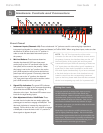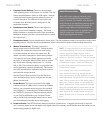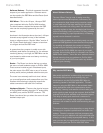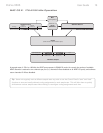
User Guide 10ProFire 2626
Software Returns – This block represents the audio
outputs of your audio application. Software returns
can be routed to the DSP Mixer and the Router (both
described below).
DSP Mixer – This is the 18 input, 16 output DSP
mixer contained within the ProFire 2626 interface.
The block features a dashed line because the DSP
mixer can be completely bypassed by the user if
desired.
As shown in the illustration above, the mixer’s 18 input
channels accept signals from any of the hardware
inputs or software returns. See the “Mixer” section of
the “Control Panel Application” chapter to learn how
to configure and use the DSP mixer.
In cases where the computer is unable to run with
sufficiently small buffer size settings (i.e., the software
monitoring latency is too high), the DSP Mixer can be
used instead to achieve near-zero latency monitoring
of your input signals.
Router – The Router is a device that lets you select
the source of each hardware output on ProFire 2626.
These sources include any pair of hardware inputs,
the main output of the DSP mixer or any of its seven
auxiliary sends, and any available software return pair.
The router is an extremely useful tool since it allows
you to reconfigure how audio streams flow out of the
interface without having to physically re-patch the
cables connected to the back of the interface.
Hardware Outputs – These are the physical outputs
of ProFire 2626 including the eight 1/4” analog jacks,
two ADAT ports, and the S/PDIF connector. The
Router (see above) lets you select the source of each
hardware output pair.
About Software Returns:
The term “Return” has its roots in analog recording,
where input sources (Microphones, Instruments, etc.)
are connected to large format mixing consoles, routed
to multi-track reel-to-reel tape machines for recording
and then returned to the mixing desk. This allows the
recording engineer to hear the recorded signal from tape
while the recording is still in process. This way, problems
with the recording (e.g. tape imperfections, or distorting
signals) can be detected in real-time.
While recording systems have evolved greatly over the
years and DAW applications have become more popular
for recording and playback, the concept of returning
signals from your recording device has not changed. In
the case of the ProFire 2626, the output of your audio
software (the recording device) is returned to the ProFire
2626 Router section – hence the term “software returns.”
Signals returning from your software to ProFire 2626
can then be sent to the DSP mixer and/or any hardware
output of your choosing.
Why use the DSP Mixer?
Most audio applications include mixing and monitoring
functionality and you may be wondering why you
would want to use the ProFire 2626 DSP Mixer for
monitoring instead of the DAW application. The main
reason for using the DSP Mixer is that software-based
audio applications suffer from a phenomenon known
as “latency.” Latency is the amount of time it takes your
audio signals to pass through the computer (and its DAW
software) and become available at the hardware outputs.
This delay is usually quite small and is measured in
milliseconds, but it may be large enough to distract a
performer who wishes to record while monitoring through
software.
The amount of latency varies depending on many factors
including your computer’s performance and buffer size
settings. Powerful computers with fast processors may
allow you to run your sessions with very small buffer size
settings, providing virtually imperceptible latency. In this
case, you can use your application’s software monitoring
features and bypass the ProFire 2626 DSP Mixer.


















